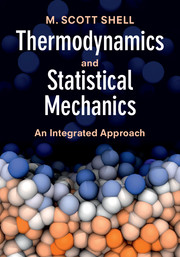Book contents
- Frontmatter
- Contents
- Preface
- Reference tables
- 1 Introduction and guide for this text
- 2 Equilibrium and entropy
- 3 Energy and how the microscopic world works
- 4 Entropy and how the macroscopic world works
- 5 The fundamental equation
- 6 The first law and reversibility
- 7 Legendre transforms and other potentials
- 8 Maxwell relations and measurable properties
- 9 Gases
- 10 Phase equilibrium
- 11 Stability
- 12 Solutions: fundamentals
- 13 Solutions: advanced and special cases
- 14 Solids
- 15 The third law
- 16 The canonical partition function
- 17 Fluctuations
- 18 Statistical mechanics of classical systems
- 19 Other ensembles
- 20 Reaction equilibrium
- 21 Reaction coordinates and rates
- 22 Molecular simulation methods
- Index
- References
3 - Energy and how the microscopic world works
Published online by Cambridge University Press: 05 April 2015
- Frontmatter
- Contents
- Preface
- Reference tables
- 1 Introduction and guide for this text
- 2 Equilibrium and entropy
- 3 Energy and how the microscopic world works
- 4 Entropy and how the macroscopic world works
- 5 The fundamental equation
- 6 The first law and reversibility
- 7 Legendre transforms and other potentials
- 8 Maxwell relations and measurable properties
- 9 Gases
- 10 Phase equilibrium
- 11 Stability
- 12 Solutions: fundamentals
- 13 Solutions: advanced and special cases
- 14 Solids
- 15 The third law
- 16 The canonical partition function
- 17 Fluctuations
- 18 Statistical mechanics of classical systems
- 19 Other ensembles
- 20 Reaction equilibrium
- 21 Reaction coordinates and rates
- 22 Molecular simulation methods
- Index
- References
Summary
Quantum theory
To conceptualize the molecular origins of thermodynamic equilibrium, one must first understand the elemental ways by which molecules interact. How does the world really work? What are the most fundamental principles that form the basis of reality as we know it?
Currently our understanding of reality rests upon two principal concepts in physics: quantum theory and relativity. Both of these have been subjected to stringent experimental tests over the past century, and their combination has in part led to a deep understanding of elementary particles. There still remain some incompatibilities between the two, namely in understanding the nature of gravity, and there have been intense efforts to find new fundamental physical explanations. However, for the purposes of our discussion, we will focus solely on quantum theory since for nearly all of the models and systems that we will discuss one can safely avoid considerations of relativistic effects.
Quantum mechanics describes the complete time evolution of a system in a quantum sense, in a manner analogous to what Newtonian mechanics does for classical systems. It is most easily described in terms of a system of fundamental particles, such as electrons and protons.
- Type
- Chapter
- Information
- Thermodynamics and Statistical MechanicsAn Integrated Approach, pp. 21 - 49Publisher: Cambridge University PressPrint publication year: 2015

